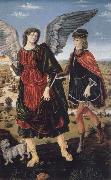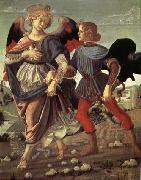
Oil On
Canvas, Real Flavor of Old Masters
|
Antonio Pollaiuolo
|
|||
|
|
|||
| 1431-1498 Italian Antonio Pollaiuolo Galleries Sculptor, painter, designer and engraver. He was trained as a goldsmith and bronze sculptor, probably in Lorenzo Ghiberti workshop. In 1466 he joined the Arte della Seta, the silkworkers guild (to which goldsmiths traditionally belonged), and he listed himself as a goldsmith and painter in the membership records of the Compagnia di S Luca in 1473; this is the only documented reference to him as a painter. In his tax return in 1480 he reported that he was renting a workshop specifically for goldsmiths work. He still described himself as a goldsmith, and not as a painter, in his last tax return in 1496. | |||
|
|
|||
|
|
Tobias and the Angel Antonio Pollaiuolo5.jpg Painting ID:: 1590 Visit European Gallery |
1460 Galleria Sabuda, Turin | |
Height Width |
INS/CM |
||
|
X |
|
||
|
|
|||
|
Jacopo Vignali
|
|||
|
|
|||
| Italian painter who died on 03 August 1664 Italian painter. At an early age he entered the studio of Matteo Rosselli in Florence, and his first works, Virgin and Saints (1616; Florence, S Brigida, Santuario della Madonna del Sasso) and the ceiling painting Love of the Fatherland (1616; Florence, Casa Buonarroti), were influenced by Rosselli and Ludovico Cigoli. In 1616 he enrolled at the Accademia del Disegno in Florence, becoming an academician in 1622. In the 1620s he moved away from Rosselli's influence and developed a style distinguished by dramatic light effects, rich colour and painterly technique and by the expression of deep emotion. The decade opened with the Investiture of St Benedict (1620; Florence, Semin. Maggiore), one of a series of works painted in honour of St Benedict for the Confraternit? di S Benedetto Bianco, to which Vignali had belonged since 1614. Having learnt the technique of fresco painting from Rosselli, he also began to work in that medium and was involved in the decoration of the Casa Buonarroti throughout the decade, the ceiling fresco Jacob's Dream dating from 1621. | |||
|
|
|||
|
|
Tobias and the Angel new3/Jacopo Vignali-544297.jpg Painting ID:: 28969 Visit European Gallery |
mk65 Oil on canvas 52 3/8x63 3/8in | |
Height Width |
INS/CM |
||
|
X |
|
||
|
|
|||
|
unknow artist
|
|||
|
|
|||
|
|
|||
|
|
Tobias and the angel new17/unknow artist-862828.jpg Painting ID:: 45535 Visit European Gallery |
mk186 around 1465 Turin, Galleria Sabauda | |
Height Width |
INS/CM |
||
|
X |
|
||
|
|
|||
|
Andrea del Verrocchio
|
|||
|
|
|||
| Italian Early Renaissance Sculptor, ca.1435-1488 Florentine sculptor and painter, whose real name was Andrea di Michele di Francesco di Cioni. He was a leading figure in the early Renaissance, and his workshop was a center for the training of young artists in Florence. A virtuoso metalworker, Verrocchio was primarily concerned with the spirited rendering of movement and the elaboration of detail. Many of his paintings are lost. Of the remaining panels, his hand is evident in the Baptism of Christ (Uffizi), assisted by Leonardo da Vinci. In the Pistoia altarpiece he was aided by Lorenzo di Credi. Other attributions are Tobias and the Angel (National Gall., London), two paintings of the Madonna and Child (National Gall., London; Berlin), and a Crucifixion with Saints (Argiano). Most of Verrocchio's achievements in sculpture have survived. His earlier work includes the bold group Incredulity of St. Thomas (Orsanmichele). In 1472 he designed the tombs of Piero and Giovanni de' Medici (San Lorenzo). In the same period he created the graceful Boy with a Dolphin and a lithe portrayal of David (Bargello). He went to Venice (c.1480) to work on the equestrian monument of the condottiere Bartolomeo Colleoni. | |||
|
|
|||
|
|
Tobias and the Angel new19/Andrea del Verrocchio-327875.jpg Painting ID:: 51772 Visit European Gallery |
nn09 c.1470-800 33x26in | |
Height Width |
INS/CM |
||
|
X |
|
||
|
|
|||










